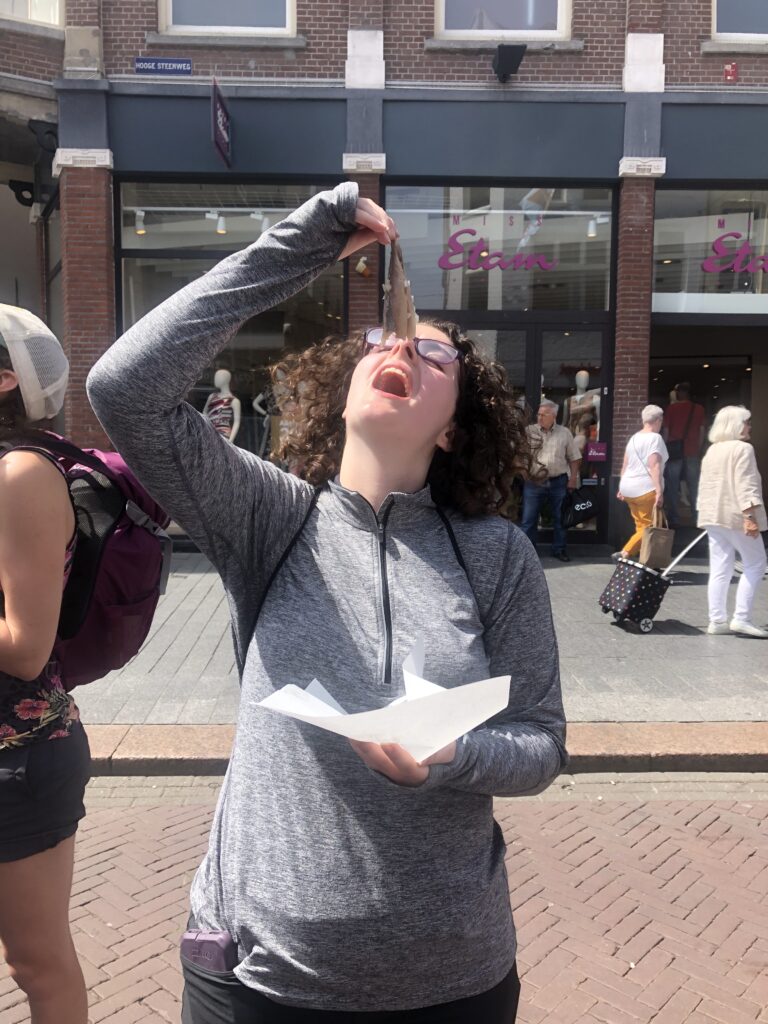By Allison, Wildlife and Fisheries Biology; Sophomore
We started off the day by biking from Amrath Hotel Bevoir in Nijmegen to the local train station. In order to get everyone from Nijmegen to Hertogenbosch or also called Den Bosch, we split up into several groups to take the inner city train. We went to the Den Bosch market which had a variety of different foods, clothing, jewelry and much more to choose from. A few of us went to Bagels and Beans for breakfast, while others got food from the market. We even bought some strawberries to share with everyone as well as raw herring with onions for everyone to try around lunchtime. To try the fish we held the tail above us looking up to eat it. Besides enjoying and trying new foods at the market, we all walked to the Cathedral. One of our goals was to find the angel who was wearing jeans!

We then proceeded to meet up with Kris’ sister in law who lives in the Netherlands before heading to Kring Vrienden water museum. An incredible volunteer named Hugo, who was on the board of the Water Authority for eight years, gave us a powerpoint presentation about changing paradigms sustaining life along the Netherlands Great Rivers. Ten thousand years ago, the Rhine River was 120 meters lower than it is today due to the weight of the ice that was on it during the ice age. In areas of the Netherlands, remains of ancient trees and bones of mammoths that used to roam the area have been found. In 1883, the Rhine and Meuse rivers intertwined. Hugo mentioned that the Netherlands measures about 41.543 km3 and gave some statistics. Approximately 26% of land lies below sea level, 29% is vulnerable to river flooding which totals about 55% of flood sensitive territory. Early settlers lived on higher ridges and plains or ‘dwelling mounds’. In 1798, one national authority for ‘water management’ was created. One of the points Hugo made that I thought was very interesting was that the water board is non-political which is very different from the United States.
There was a 1953 flood catastrophe with over 2000 casualties. Hugo was an eyewitness to this event when he was just 7 years old (having to escape to a higher level in his home as the water came in). He explained to us that after that event, the government formed a committee to ensure that such a tragic event would never happen again. The water that flooded people’s homes and a broad area of land came from the rivers, surprising people. They were preparing for water to come from the North Sea. Some current challenges the Netherlands faces include: record heat and drought, accelerated sea level rise and salt intrusion, accelerated land subsidence and decreasing surface and ground water resources. Water museums are an important part of the past, present, and future – helping people to understand the importance of water.
Following our presentation with Hugo, he took us on a boat tour on the Binnendieze River. We went through tunnels under the city, and then went outside the city walls and observed a nature reserve that was once flooded in 1995, but now has controlled filling when needed if there is high water. We were able to get off of the boat and walk around, viewing a weir that controls water levels in Den Bosch, and seeing another area of natural land that is reserved for flood control to protect the city as well.
For a treat after the boat tour, we went to Jan de Groot which sells pastries. We tried Bossche ballen which tasted like a chocolate covered cream puff and which was absolutely delicious. We then went back to the train station to get our bikes to head on to Waalwijk. We sampled Chinees Indisch food at a restaurant down the road from our hotel for dinner.
